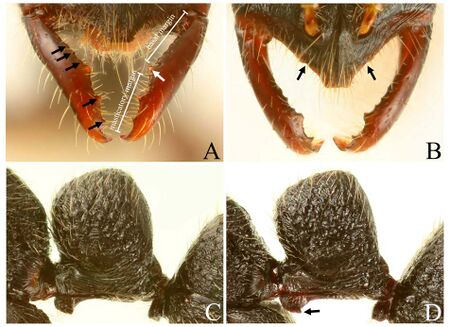Leptogenys aspera
| Leptogenys aspera | |
|---|---|

| |
| Scientific classification | |
| Kingdom: | Animalia |
| Phylum: | Arthropoda |
| Class: | Insecta |
| Order: | Hymenoptera |
| Family: | Formicidae |
| Subfamily: | Ponerinae |
| Tribe: | Ponerini |
| Genus: | Leptogenys |
| Species: | L. aspera |
| Binomial name | |
| Leptogenys aspera (André, 1889) | |
Identification
In full-face view, head longer than wide (CI: 72–77). In full-face view, eye situated anterior to mid-length of head, breaking lateral outline of head. Mandible with basal angle; basal margin with three teeth; masticatory margin with three teeth including apical tooth. Anterior edge of torulus anterior to transverse line extending across mandible bases. Clypeus projecting apically into trapezoidal lobe, with longitudinal median carina; apex truncate; median lobe short (CLI: 15–17). Hypostomal tooth absent. Petiole in profile higher than long, in dorsal view longer than wide; in profile, petiolar node rectangular, highest posteriorly; anterior and posterior margins inclined anteriad. Subpetiolar process consisting of fan-shaped anterior lobe and thin posterior extension.
This species is easily recognized by the remarkable structure of the mandible with seven teeth (three short teeth on basal margin, basal angle, two distinct teeth on masticatory margin and an acute apical tooth) (Fig. 4A).
 Arimoto, 2017, Fig. 4. Leptogenys aspera, workers. A, B: from Thailand; C, D: from Laos. A: mandible, frontal view (black arrows: teeth; white arrow: basal angle); B: ventral half of head, full-face view (arrow: notch on anterolateral margin of clypeus); C: petiole, lateral view; D: ditto (arrow: acute posteroventral angle of anterior lobe).
Arimoto, 2017, Fig. 4. Leptogenys aspera, workers. A, B: from Thailand; C, D: from Laos. A: mandible, frontal view (black arrows: teeth; white arrow: basal angle); B: ventral half of head, full-face view (arrow: notch on anterolateral margin of clypeus); C: petiole, lateral view; D: ditto (arrow: acute posteroventral angle of anterior lobe).
Keys including this Species
Distribution
Arimoto (2017) did not find evidence of this species occurring in Sulawesi, Indonesia. The record from Sulawesi based on the larva described by Wheeler & Wheeler (1976) is most likely a misidentification.
Latitudinal Distribution Pattern
Latitudinal Range: -4.197° to -4.197°.
| North Temperate |
North Subtropical |
Tropical | South Subtropical |
South Temperate |
- Source: AntMaps
Distribution based on Regional Taxon Lists
Indo-Australian Region: Borneo, Indonesia, Malaysia.
Oriental Region: Vietnam (type locality).
Distribution based on AntMaps
Distribution based on AntWeb specimens
Check data from AntWeb
Countries Occupied
| Number of countries occupied by this species based on AntWiki Regional Taxon Lists. In general, fewer countries occupied indicates a narrower range, while more countries indicates a more widespread species. |

|
Estimated Abundance
| Relative abundance based on number of AntMaps records per species (this species within the purple bar). Fewer records (to the left) indicates a less abundant/encountered species while more records (to the right) indicates more abundant/encountered species. |

|
Biology
Castes
Queen and male unknown (Arimoto, 2017).
Nomenclature
The following information is derived from Barry Bolton's Online Catalogue of the Ants of the World.
- aspera. Lobopelta aspera André, 1889: 222 (w.) VIETNAM. Wheeler, G.C. & Wheeler, J. 1976a: 52 (l.). Combination in Leptogenys: Forel, 1900d: 310. See also: Bingham, 1903: 60.
Taxonomic Notes
Arimoto (2017) examined specimens from the four areas: central Vietnam, central Laos, east Thailand, and south Thailand. Measurements of body parts in these specimens showed no noticeable variation between the populations. However, variation was found in the shape of the propodeum. In the specimens from central Laos the propodeal dorsum and declivity form a continuous curve, while in those from Vietnam and Thailand the dorsum is separated from the declivity by a blunt angle. The two ‘forms’, here considered to represent geographical variation, are allopatric in range. Morphological variation among sympatric individuals was observed in the proportion of the anterior lobe of the subpetiolar process (Fig. 4C, D), body surface sculpture, and coloration.
Description
References
- Andrè, E., 1889. Hyménoptères nouveaux appartenant au groupe des formicides. Revue d'Entomologie (Caen), 8: 217–231 (doi:10.5281/zenodo.27105).
- Arimoto, K. 2017. Redescription of Leptogenys aspera (André, 1889) (Hymenoptera, Formicidae, Ponerinae) from Southeast Asia. Japanese Journal of Systematic Entomology, 23 (1): 15–19.
- Bingham, C. T. 1903. The fauna of British India, including Ceylon and Burma. Hymenoptera, Vol. II. Ants and Cuckoo-wasps. London: Taylor and Francis, 506 pp. (page 60, see also)
- Dalla Torre, C. G. de, 1893. Catalogus hymenopterorum hucusque descriptorum systematicus et synonymicus. Volumen VII: Formicidae (Heterogyna). Sumptibus Guilelmi Engelmann, Lipsiae. 289 pp.
- Emery, C., 1911. Hymenoptera. Fam. Formicidae. Subfam. Ponerinae. Genera Insectorum, 118: 1–125.
- Forel, A. 1900f. Les Formicides de l'Empire des Indes et de Ceylan. Part VII. J. Bombay Nat. Hist. Soc. 13: 303-332 (page 310, Combination in Leptogenys)
- Wheeler, G. C. & Wheeler, J., 1976. Supplementary studies on ant larvae: Ponerinae. Transactions of the American Entomological Society, 102: 41–64 (doi:10.5281/ zenodo.25098).
References based on Global Ant Biodiversity Informatics
- Arimoto K. 2017. Redescription of Leptogenys aspera (André, 1889) (Hymenoptera, Formicidae, Ponerinae) from Southeast Asia. Japanese Journal of Systematic Entomology 23 (1): 15–19.
- Chapman, J. W. & Capco, S. R., 1951. Check list of the ants (Hymenoptera: Formicidae) of Asia. Monographs of the Institute of Science and Technology, 1: 1–327.
- Forel, A., 1900. Les formicides de l'Empire des Indes et de Ceylan. Part VII. Journal of the Bombay Natural History Society, 13: 303–332. http://10.5281/ZENODO.14396
- Ogata K. 2005. Asian ant inventory and international networks. Report on Insect inventory Project in Tropic Asia TAIIV: 145-170.
- Pfeiffer M.; Mezger, D.; Hosoishi, S.; Bakhtiar, E. Y.; Kohout, R. J. 2011. The Formicidae of Borneo (Insecta: Hymenoptera): a preliminary species list. Asian Myrmecology 4:9-58
- Xu Z. H., and Q. J. He. 2015. Taxonomic review of the ponerine ant genus Leptogenys ROGER, 1861 (Hymenoptera: Formicidae) with a key to the Oriental species. Myrmecological News 21: 137-161.



